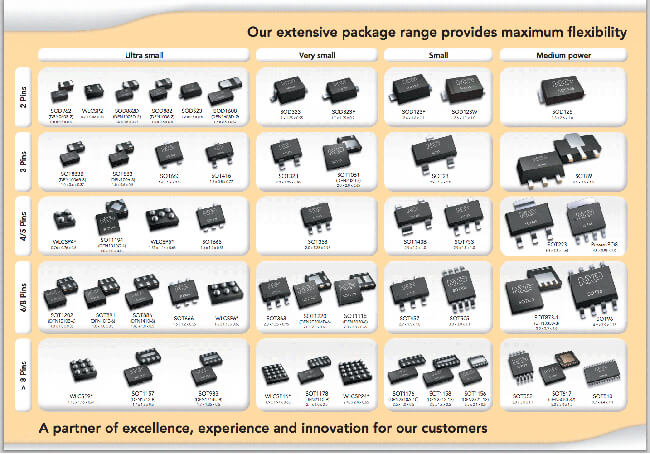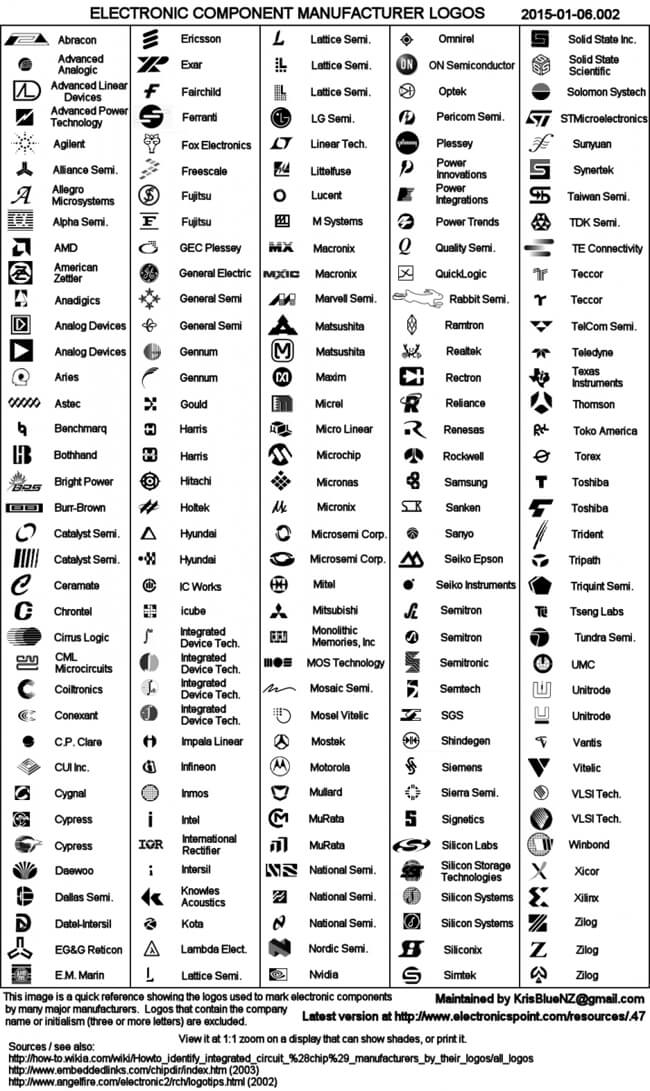Home > SMT Assembly News
Identify the package, note how many pins, match up the pins first. Note that sometimes the package pins are underneath the part or extended away from the part. Also get the dimensions of the part with a ruler or calipers and match them up with a chart, write them down for a later step.
Package dimensions are standardized IPC-7351 or they can also be found by searching for the package type on google and comparing dimensions. Package dimensions can also be found at manufactures websites in datasheets (or sometimes in files separate from datasheets, it might take some hunting around to find them)
Here are some resources to help you find different packages or use this below:
 Source: NXP
Source: NXP
Step 2) Identify all markings on the top of the component. These markings include: Manufacturer Logo and\or SMT code.
If you are unsure of character differences, make sure these are noted. E.g.: 8 could be mistaken for B. That means if you have A32B it could be mistaken for A328. If you're unsure, you will need to search for both. Here are some sources where you can find them:
You can find many IC manufacturer logo's using this link or the picture below:

Source: Electronicspoint
Step still can't find it 3) So what do you do at this point if you can't find what your part is? There are still lots of options. Use what you know about the part.
A manufacture logo or mark on the package can be really helpfull to identify the package. Use parametric searches at the manufacturer's website and package information to narrow down the number of parts. For example: if I thought the part was an opamp with 5 pins and I knew the manufacturer was TI, I would go to TI's website and run a parametric search that looks for all of the opamps with 5 pin packages.
Then start checking datasheets as most of the leading manufactures provide SMT codes in datasheets with the package information. If it is an old part, a search through old datasheets or maybe an email to the manufacturer might be the way to clarify the part. Many manufacturers have also SMD code lists.
The more certainty you have of the package type (or narrowed it down to a few packages) and you think you know what the part does, you can use a distributor search (such as Digikey, Mouser, or Octopart) to narrow down what the part is. This allows you to pull up a datasheet and check.
I have also found extremely vague parts on google just by the package and the SMD number. I tried different combinations of packages (I had two choices), and after some google sleuthing, I narrowed it down to 3 parts. With some testing, I found my part.
If all that doesn't work, and your part is still functional, you might have to do more reverse engineering of the circuit and find the functionality of the part.
For example, if you know its a transistor, you could verify the type of transistor with a multi meter or diodes can be easily determined with the diode mode of a meter.
Because of current leakage in a circuit when it is off, parts such as capacitors or unmarked resistors may need to be desoldered from the board to find the true value (the rest of the circuit is in parallel with the component when the terminals of the meter are placed across it).
Keywords:
SMT Reflow Oven, Lead free Reflow Oven, Reflow Oven Manufacturer, LED reflow oven, PCB Reflow Oven, Nitrogen Reflow Oven, Dual Rail Reflow Oven, China Reflow Oven, wave soldering machine, Dual Rail Wave Soldering Machine, Nitrogen Wave Soldering Machine, Wave Soldering Machine Manufacturer.
Flason Electronic Co.,ltd provide a full SMT assembly line solutions, including SMT Reflow Oven, Wave Soldering Machine, Pick and Place Machine, SMT Stencil Printer, SMT AOI SPI Machine, SMT Reflow Oven, SMT Peripheral Equipment, SMT Assembly line, SMT Spare Parts etc any kind SMT machines you may need, please contact us for more information: wechat whatsapp:+8613691605420, Skype: flasonsmt, Email: sales@flason-smt.com



Contact: Mr Tommy
Phone: +86 13691605420
Tel: +86 -755-85225569
Email: sales@flason-smt.com
Add: No.94,Guangtian Road,Songgang Street,Bao an District Shenzhen China